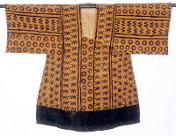Enter your keywords separated by spaces and click Search. Records that match your search
terms will be returned.
-
You can join terms with OR to match any, e.g. knife OR blade
-
To search for Catalog Numbers, replace spaces with dashes, e.g. instead of ABC 12345, use ABC-12345. Do not include any other terms.
Keyword search example: knife sri lanka
The results of your searches can be displayed in Grid (a sortable, customizable table)
or Gallery View (best for reviewing images). Use the Switch button
 to cycle between these views.
to cycle between these views.
-
You can choose whether to display 5, 10, 20, 50, or 100 records at a time.
In Grid View:
-
You can choose the columns to display from any column's dropdown menu (mouse into
a column header and click the dropdown icon). Under Columns, click the name
to display or hide the field (you do not need to click the checkbox specifically).
-
You can drag a column header to change its order of appearance in the grid.
-
You can also drag the edge of a column to make it wider or narrower.
-
Click in the expansion
(
 )
column to view the full record.
)
column to view the full record.
In Gallery View:
-
Click the image to view the full record.
See Exporting Results for information on downloading results to, for example,
Excel.
Open the full collection record by clicking the expansion button
( )
in Grid View,
or anywhere within the image frame in Gallery View. Inverse expansion buttons
(
)
in Grid View,
or anywhere within the image frame in Gallery View. Inverse expansion buttons
( )
indicate records with multimedia (typically, images).
)
indicate records with multimedia (typically, images).
-
In the Record window, metadata for the multimedia content is available when you mouseover the thumbnail.
-
Clicking the thumbnail opens the content in your browser or other appropriate application.
-
Record windows may be resized or moved within the browser window.
-
You may have up to ten Record windows open at any one time.
Sort results in Grid View by clicking the column header (or by choosing Sort from
the column's dropdown menu).
-
Sort on multiple columns by consecutively sorting columns in reverse order.
For example, to view results sorted by Country and Province/State, first sort by
Province/State and then sort again by Country.
-
For any column you can choose to sort in Ascending or Descending order.
Export all or selected results by clicking the Export Results as CSV button in the
bottom toolbar in Grid
or Gallery View.
-
Select individual records for Export by checking the export selection box
(along the left edge of the Grid View grid).
-
Clear all selections with the Clear Selections button in the bottom toolbar.
-
Results are exported as comma-separated-values, one record per line, which can be saved
to disk or opened directly with applications such as Microsoft Excel.
Here are a few search tips:
-
Query results are limited to 5000 records. Avoid very general queries that
return very large numbers of records, e.g. searching for arrow.
-
You can choose which columns to display in the Grid View of your search results.
Move your pointer to any column header and click on the dropdown arrow. Scroll
to Columns and then check or uncheck column names to show or hide those
columns in the grid.
-
Some terminology has not been standardized. If you do not find what you are looking for,
try synonyms and alternate spellings.
-
Ethnology records often have a culture listed, but not a specific locality. Therefore,
if you are looking for ethnology collections from a certain place, you may find more
records by searching for the culture associated with that area (for example, Korean
rather than South Korea)
-
Archaeology records often have a site or geographic information listed, but not a culture.
Therefore, you may find more records by searching by country, state, or site, rather than
culture names or time periods (for example Cahokia rather than Mississippian)
-
Information about this database, image use policies, and other sources of information are
available in the Introduction.
To create a link to specific records at NMNH provide a querystring for:
https://collections.nmnh.si.edu/search/anth/?QUERYSTRING
where QUERYSTRING is (use a plus-sign to separate case-insensitive terms):
-
One or more CATALOG NUMBERS, e.g.
-
anth/?nb=1280+1281+ec1282
-
anth/?nb=a-573524
-
The NAME of an object, e.g.:
-
anth/?qn=dagger
-
anth/?qn=woven+basket
-
One or more SITE NUMBERS (replace punctuation with an underscore), e.g.:
-
anth/?sn=tx_cm_6 (for Station Number: TX-CM-6)
-
anth/?sn=la_88+j_1+9br60_a (for: LA 88, or J.1, or 9BR60-A)
-
anth/?sn=mu
-
A GENERAL query, searching on any combination of: OBJECT NAME (qn), ACCESSION NUMBER (an),
COLLECTOR (cr), STATION NUMBER (sn), or WITH IMAGES ONLY (io), e.g.:
-
To open the Collections Search to a specific search tab, e.g.
-
anth/?ti=2 (Search by Field)
Tabs are numbered left to right, beginning with zero.
It is best to use only letters, numbers, pluses (+), dashes (-), and commas in your querystrings,
and to avoid other characters.








 to cycle between these views.
to cycle between these views.



